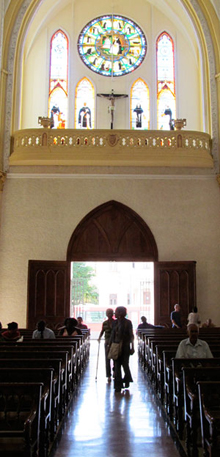We filed quietly up the stairs, scarves pulled over our hair as a sign of respect, into the local imam's small but cheerful living room, which was filled with Muslim women gathered for afternoon prayers. They welcomed our group enthusiastically, breaking out drinks, crackers, and cookies.
They were as curious about our lives and perceptions as we were about their religious lives as Muslims in Cuba. According to a Pew Research Center report from 2009, there are 9,000 Muslims in Cuba, or 0.1 percent of the population. (Most religious Cubans practice Catholicism or a blend of Catholicism and African religions, such as Santeria.)

Emory's Journeys group found a surprising diversity of faiths and denominations in Cuba, as they toured Catholic cathedrals, Jewish centers, Methodist seminaries, and Santeria sites, among others.
Through an interpreter, the imam, a tall man with kind eyes and a white beard, said that a mosque was being built in Havana soon—a long-rumored dream of local Muslims and promised relief to the men crowded onto the open-air porch of the imam's home.
"We feel accepted here," said one of the women, a lawyer by profession, as is her daughter. "We do not have trouble."
That was the consensus of most of the religious leaders and laypeople we spoke with as part of a Journeys group from Emory that visited Cuba for 10 days in May to investigate issues of religion, race and reconciliation.
Journeys, a program of the Dean of the Chapel and Religious Life, enables Emory students, staff, faculty and alumni to visit parts of the world that have experienced internal and external conflict.
Since Cuba, just 90 miles south of Florida, is still under economic embargo and travel restrictions from the U.S., the group gained permission to visit under a religious license issued by the U.S. Treasury, and took a 40-minute chartered flight from Miami into Havana's Jose Marti Airport the morning of May 15.
The Journeys group consisted of associate dean of the chapel and religious life Lisa Garvin; Muslim religious life adviser Isam Vaid, who is an Oxford, Emory and School of Public Health alumnus; Journeys coordinator Cynthia Shaw; associate professor of political science Michael Leo Owens and his wife, Emory Healthcare administrator Karen Cobham-Owens; English graduate student Nicole Morris; recent Emory College graduates Michael David Harris, Jarvis Dean and Christine Hines; and Emory students Adam Loftus, Emilia Truluck, Candace Pressley and myself.
We stayed in the Havana Libre, formerly the Havana Hilton, and famous as the spot where Fidel Castro set up his offices on the 23rd floor for a few months after the 1959 Revolution.
"Cuba is a secular state, not an atheistic one, according to its constitution," says Owens, an expert in politics and religion and author of "God and Government in the Ghetto: The Politics of Church-State Collaboration in Black America."
"Our main objective was to learn about Cuba's religious pluralism, as well as the degrees of religious liberty under a Socialist state. The 'reality' I observed was a rich diversity of faiths and denominations, worshiping without fear but with some frustration toward the state."
The faith sector is regulated by the state, and the Communist Party of Cuba, in terms of the growth, locations and social activities of houses of worship, says Owens, which "further mutes the political voices from houses of worship. Yet the religionists on the island generally seemed hopeful that relations with the Cuban government are improving. Plus, the number of adherents to some religions are increasing at a fast pace, especially Evangelicals and Santeros of all sorts. I left Cuba feeling that the state is slowly reforming itself in ways that will ultimately strengthen the nation's faith sector."
Still, says Owens, "much of what one sees and hears in Cuba and takes away from it are suspect."
Our group also toured Convento de San Francisco de Asis, a church from Cuba's colonial period; the ecumenical Martin Luther King Center; the Jewish congregation Centro Hebreo Safardi de Cuba and its Holocaust Remembrance Hall; the Cathedral of Cienfuegos; the Patronato Jewish Community Center; a Methodist seminary; the community organization Cabildoquisicuaba; Our Lady of Kazan Cathedral Russian Orthodox Church; and St. Nicholas Greek Orthodox Church, among other houses of worship. We had lunch with a Santeria priest, toured a slave museum, and met with Caridad Diego, head of the Cuban Communist Party Office of Religious Affairs.
Rev. Garvin was surprised to find such "vibrant religious communities and diverse practices." After the communist revolution, Cuba restricted religious practice, and 80 percent of the professional Catholic priests and Protestant ministers left for the U.S. Today, the Cuban government states that it recognizes the right of citizens to "profess and practice" any religious belief.
"Because the conflict in Cuba has historically been against state imposed atheism and ancestral religion brought from Africa or Spain, I think there is a promising space on the island for interfaith cooperation and dialogue," says Truluck, a rising sophomore at Emory whose ancestry is Cuban.
"There has not historically been tensions between religions as there has in the rest of the world that I've visited," Truluck adds, "but there also hasn't been much cooperation— that's what happens when congregations spend most of their time under the radar, I suppose. I can't wait to see how religious organizations blossom and grow together on such a fairly clean slate of religious expression."

